![]()
I have a youtube channel with over 1000 Project Videos!

Hi, Thanks for visiting my website. My name is Will and if you have questions
or would like to
contribute projects or ideas you can contact me 

![]()
I have a youtube channel with over 1000 Project Videos!

Hi, Thanks for visiting my website. My name is Will and if you have questions
or would like to
contribute projects or ideas you can contact me 
Pictures, explanations and information about Medieval weapons including swords, halberds, flails, maces and more. The middle ages saw the creation and use of many types of weapons and these weapons developed over time as armor developed and improved and as the technology of metal working evolved.

BladesUSA Fantasy Medieval Battle Axe with Display Plaque - 21-inch
Sure to garner a lot of attention when on display in your home, the BladesUSA Fantasy Medieval Battle Axe with Display Plaque (model HK-079A) has a dual headed axe is made in the fashion typically associated with a fantasy-themed battle axe -- though it is smaller in stature and made to hold effectively in one hand. The axe-head is double-bladed, with twin blades extending out of either side of the haft in a fairly typical crescent-blade design. The cap of the haft is set with a four-flanged topper, designed for extra weight and design. The haft is near equal parts stainless steel and black finish, with two bands of spike-studded steel as decoration, while the wire-wrapped grip provides all the leverage and security needed for holding the weapon. This two-bladed axe comes complete with a display plaque. The axe measures 21-inches overall.
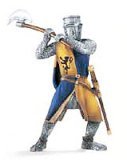
Foot Soldier with Battleaxe - Schleich World of Knights Figure This is a great image of a foot soldier wielding a battleaxe. Schleich hand painted figures are noted for their beautiful art work and detail.
There are two types of weapons that we will review: Melee weapons and Polearms.
Melee Weapons are weapons that were used for fighting up close to your opponent. The most common and most widely used of these weapons is the sword. But there were many other types including daggers, knives, warhammers, maces, flails the morningstar and the club.
Polearm Weapons were usually in excess of six feet long and were used in order to keep a distance between yourself and your foe. Good use of a polearm weapon made it difficult for a foe to get up close and use his melee weapon. Polearm weapons were also instrumental when fighting against mounted opponents. These weapons included the Lance, Spear and Halbard.
ore Information
- Close combat weapons developed dramatically over the several hundred years of the Medieval Period and this development was fueled by two factors: The improvement of metal working skills and the improvement of armor.
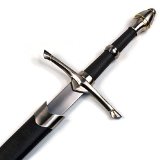
Medieval Crusader Sword with Scabbard -
Enter the Iron age of swords - Around the 13th century BC iron working skills brought about the ability to mass produce Iron swords. These swords, although not of the highest quality did make it possible to equip large armies with weapons.
![]()
The Middle Ages Changed the Sword - This occurred between the 11th and 13th century. The most important change was the addition of the quillion (also known as the cross guard). This quillion protected the wielders hand. The Sword at left shows a very large quillion. Anduril, sword of King Elessar
The Late Middle Ages After the 13th century
As Armor made advances in its abililty to protect so the sword also made advances in its ability to thwart the defenses. Some of the advances during this time are the longer handle which allowed for two handed use and a variety of specialized swords that could cut and thrust; seeking out weaknesses in armor.
The Modern Era
One of the biggest advances in the modern era was the development of the basket that protected the hand. This first appeared in Rapiers. Advances in metal working created swords that were lighter and quicker yet stronger. As weapons technology advanced the sword made the transition into a gentlemanly accoutrement used only for personal defense and then finally as sidearms became more available the sword fell from common use.
Daggers
The Dagger has had a very long history and over the century it also obtained the reputation of being a weapon of dishonor. It was considered a weapon of subterfuge. A person could keep it hidden and use it when not expected. During the Middle Ages this was considered an act of cowardice and lacking chivalry. The dagger was not used widely in combat situations with the exception of the Stiletto. Dark Assassin Dagger w/ Sheath
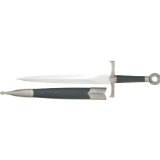
The Stiletto is a very long dagger witha very narrow blade that could be used to find weak spots in an opponents armor. Medieval Dark Ages Dagger
WarHammers
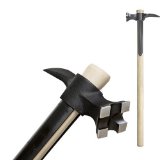
Cold Steel War Hammer The warhammer had many variations and also came in polearm length. This is a weapon that could generate tremendous blunt trauma blows to an enemy. One of the most important developments of the warhammer is the addition of the piercing beak. This enabled a warrior to pierce an enemys armor. The warhammer in the picture shows this.
Maces
Medieval Deluxe Skull Mace Dagger A mace is very similar to a warhammer in that it was used to deliver massive blunt trauma to armor. Early maces were simply balls of metal on the end of the handle. These evolved into spiked maces also called morning stars, and flanged maces which could deliver trauma and also penetrate armor. The mace shown here is a flanged mace used for penetrating armor.
Flails
Medieval Spiked FlailA flail is a close combat weapon with a handle and a striking ball at the end of a chain. The Flail was an exceptionally effective weapon. The swinging motion was a good means of protection for the wielder and it derived tremendous force. It would also easily reach up, over and around armor and shields. The flail shown here is a variant called the morning star flail. It is a flail with a morning star ball on it.
Polearm weapons are longer weapons. They developed in response to several factors. The first factor was the Horse mounted soldier. A polearm weapon was used to effectively attack a mounted soldier from the ground or to defend against one. The polearm weapon also was effective in reaching thorugh defenses such as armor and shields while maintaining safe distance from a foes shorter melee weapons. One notable use of a polearm was the use of the halberd. It often had a hook on one side that could be used to reach up, hook a rider, then pull him from his horse.
A pole weapon or polearm is a close combat weapon in which the main fighting part of the weapon is placed on the end of a long shaft, typically of wood, thereby extending the user's effective range. Spears, glaives, pollaxes and bardiches are all varieties of polearm. The idea of attaching a weapon onto a long shaft is an old one indeed, as the first spears date back to the Stone Age. The purpose of using pole weapons is either to extend reach or to increase angular momentum-and thus striking power-when the weapon is swung. Pole weapons are relatively simple to make, and they were fairly easy for most people to use effectively as they were often derived from hunting or agricultural tools. For example, the Chinese Monk's Spade, with its shovel-like end, served two purposes for the monks who used it: if they came upon a corpse on the road, they could properly bury it with Buddhist rites; and the large implement could serve as a weapon for self-defence against bandits. Massed men carrying pole weapons with pointed tips (spears, pikes, etc.) were recognized fairly early in the history of organized warfare as effective military units. On defense the men holding the polearms were hard to reach; on the attack, as in the Greek phalanx, they were devastating to those units which could not get out of the way. With the advent of armored fighters, especially cavalry, pole weapons frequently combined the spearpoint (for thrusting) with an axe or hammerhead for a swinging strike which could pierce or break armor.
Lances
A lance is a long thrusting weapon that was derived from the spear although the lance is not thrown. It is typically used by warriors mounted on horses and this is the weapon that is used in jousting competitions. These weapons were usually two to three meters in length. Very similar to the Lance was the Pike. But the Pike was usually much longer (up to 20 feet in length) and it was used by ground troops -usually againt mounted opponents. The Pike was a defensive weapon.
Spears
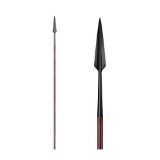
he European spear is a Prime example of effective and simple design. It is quite simply a spear done right. Its design has changed very little since the bronze age. The sheer perfect simplicity of this design has made it a timeless classic. Every inch of this high quality hunting and battlefield tool screams perfection. From its fully sharpened double edged blade to its Walnut stained American ash handle it is a beautiful all-round spear that would have pride of place in any collection
.
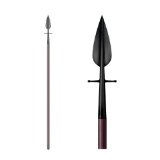
Cold Steel European Boar Spear
Our European Boar spear takes inspiration from antique germanic hunting spears. With its characteristically broad, oversized head and twin cutting edges and pronounced double quillons it is a high performance example of this iconic hunting tool. Featuring a stout Leaf shaped blade with twin cutting edges and a thick reinforcing central spine, the European Boar spear will stab and cut with surprising ease. It's sturdy quillons stop the spear from penetrating too deeply when used against dangerous game, and make excellent parrying and trapping tools when Fighting a two legged opponent. Complete with an stout, thick premium American ash shaft, the European Boar spear is sure to be very popular with the big game hunting community, re-enactors and historical martial artists.
Halberds
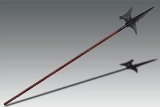
Cold Steel MAA Sargent's Halberd
Our company President Lynn C Thompson has long been fascinated by Pole Arms, Spears and Halberds. The Sergeant's Halberd is often seen as a ceremonial item, carried as a badge of rank by officers and NCOs alike in the 18th and 19th Century, it was a much feared weapon of war as well. Unlike its heavy-duty brethren (see Swiss Halberd) the Sergeant's Halberd was actually developed during the age of firearms and was designed to face foes with less protective armor. Lighter, faster and more maneuverable, the Sergeant's Halberd is a deceptively quick and astonishingly effective weapon. Our interpretation of the Sergeant's Halberd is representative of the battlefield incarnation of this historical tool. Though it features costly but attractive embellishments and ornamentation, it is a true warrior through and though. Fully sharpened and surprisingly rugged and durable, it can be used as a spear for thrusting, a hook to catch, trap and entangle and as a cutting tool to chop, cut and slice! The Sergeant's Halberd is a perfect addition to the collection of any historical re-enactor or Western Martial Artist and it makes a terrifically effective emergency self-defense tool when your life is on the line.
A Bec de Corbin is a pole weapon and in french it means "Crows Beak". Although this weapon came in many variations the typical Bec de Corbin was a long pole with a pointed end and much like the warhammer it had a hammer side and a beaked side. The beaked side was the predominant attacking side. It was capable of piercing through a knights armor. The hammer side was less frequently used as its main purpose was to balance the weight of the beak.
Resources
Looking for a book on Medieval Weapons? Here are our recommendations: